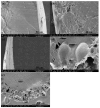Supercritical Impregnation of Olive Leaf Extract in Poly(L-lactic acid-co-caprolactone) Filaments: An Environmentally Friendly Approach to Obtaining Active Biomedical Materials
- PMID: 40508706
- PMCID: PMC12157719
- DOI: 10.3390/polym17111464
Supercritical Impregnation of Olive Leaf Extract in Poly(L-lactic acid-co-caprolactone) Filaments: An Environmentally Friendly Approach to Obtaining Active Biomedical Materials
Abstract
The valorization of by-products in the olive sector has increasingly become the focus of business and research in the context of biorefineries. This work evaluates the recovery of bioactive compounds from olive leaves and their subsequent incorporation into poly(L-lactic- acid-co-caprolactone) (PLCL) filaments through supercritical impregnation. Obtaining an olive leaf extract (OLE) using enhanced solvent extraction at a high pressure (ESE with CO2/ethanol 1:1 v/v) resulted in higher yields and concentrations of bioactives with high antioxidant and anti-inflammatory activity. No significant differences were found between the extracts obtained with different water regimes (irrigated and dry land). The supercritical impregnation of PLCL filaments showed that a low depressurization rate is essential to avoid material deformation, while the impregnation pressure and temperature influenced the OLE loading and antioxidant activity of the filaments. In vitro release studies showed the prolonged release of active compounds over 90 days, and the kinetics best fit the Korsmeyer-Peppas model, suggesting a diffusion mechanism. These results validate supercritical impregnation as a promising strategy for the development of OLE-active PLCL filaments with potential for biomedical applications requiring sustained therapeutic release.
Keywords: active compound delivery systems; olive leaf extract; poly(L-lactic-co-caprolactone) (PLCL); supercritical fluid.
Conflict of interest statement
The authors declare no conflicts of interest.
Figures










Similar articles
-
Screening of the Supercritical Impregnation of Olea europaea Leaves Extract into Filaments of Thermoplastic Polyurethane (TPU) and Polylactic Acid (PLA) Intended for Biomedical Applications.Antioxidants (Basel). 2022 Jun 14;11(6):1170. doi: 10.3390/antiox11061170. Antioxidants (Basel). 2022. PMID: 35740066 Free PMC article.
-
Mass Transfer and Optical Properties of Active PET/PP Food-Grade Films Impregnated with Olive Leaf Extract.Polymers (Basel). 2021 Dec 27;14(1):84. doi: 10.3390/polym14010084. Polymers (Basel). 2021. PMID: 35012107 Free PMC article.
-
Supercritical Impregnation of PETG with Olea europaea Leaf Extract: Influence of Operational Parameters on Expansion Degree, Antioxidant and Mechanical Properties.Polymers (Basel). 2024 Jun 1;16(11):1567. doi: 10.3390/polym16111567. Polymers (Basel). 2024. PMID: 38891513 Free PMC article.
-
Supercritical Fluid Technologies for the Incorporation of Synthetic and Natural Active Compounds into Materials for Drug Formulation and Delivery.Pharmaceutics. 2022 Aug 11;14(8):1670. doi: 10.3390/pharmaceutics14081670. Pharmaceutics. 2022. PMID: 36015296 Free PMC article. Review.
-
Microbiological and Antioxidant Activity of Phenolic Compounds in Olive Leaf Extract.Molecules. 2020 Dec 15;25(24):5946. doi: 10.3390/molecules25245946. Molecules. 2020. PMID: 33334001 Free PMC article. Review.
References
-
- Székács A. Environmental and ecological aspects in the overall assessment of bioeconomy. J. Agric. Environ. Ethics. 2017;30:153–170. doi: 10.1007/s10806-017-9651-1. - DOI
Grants and funding
LinkOut - more resources
Full Text Sources

